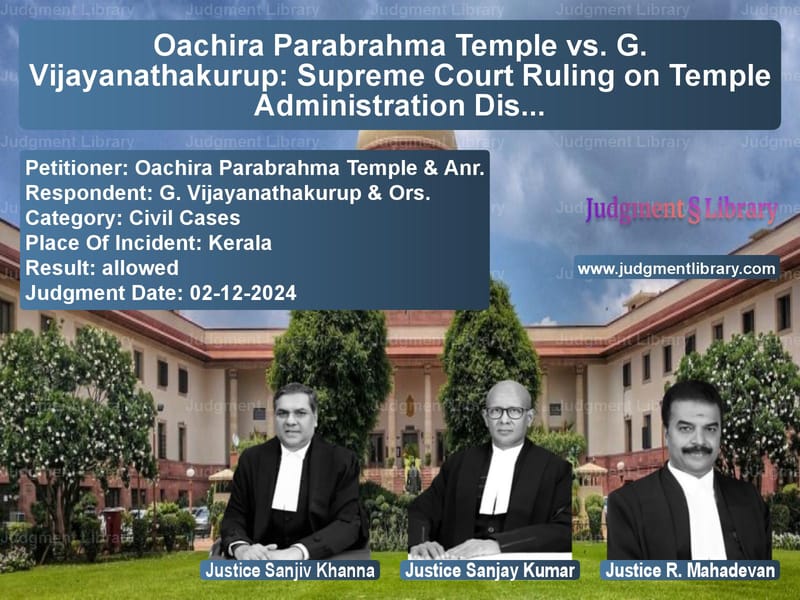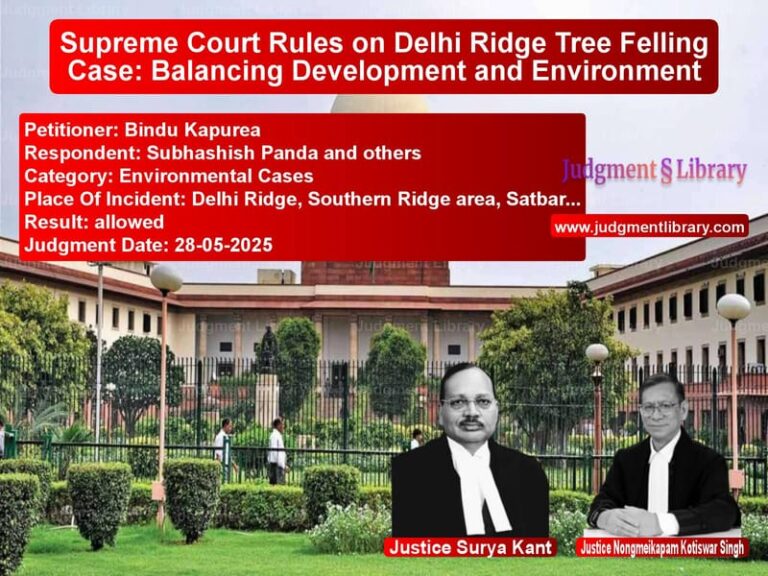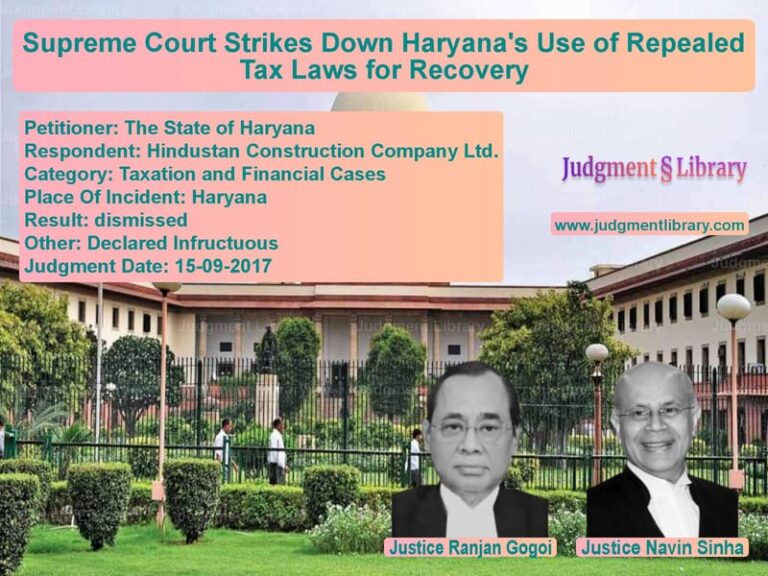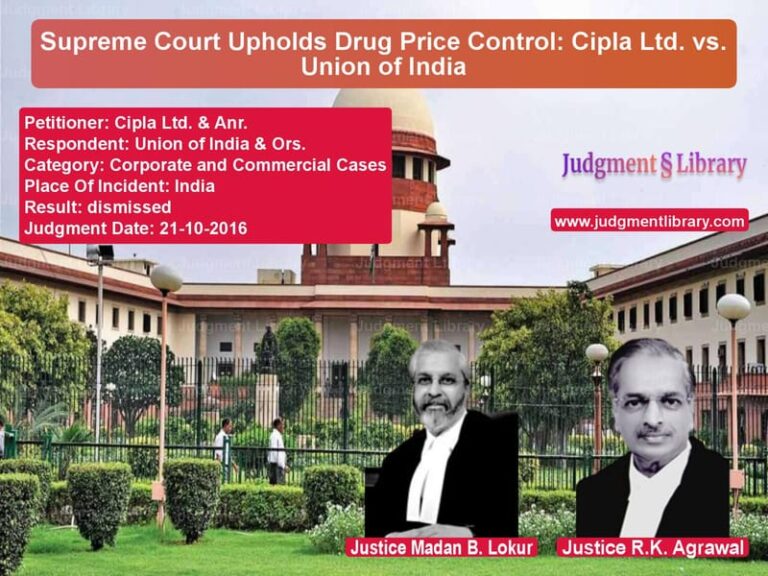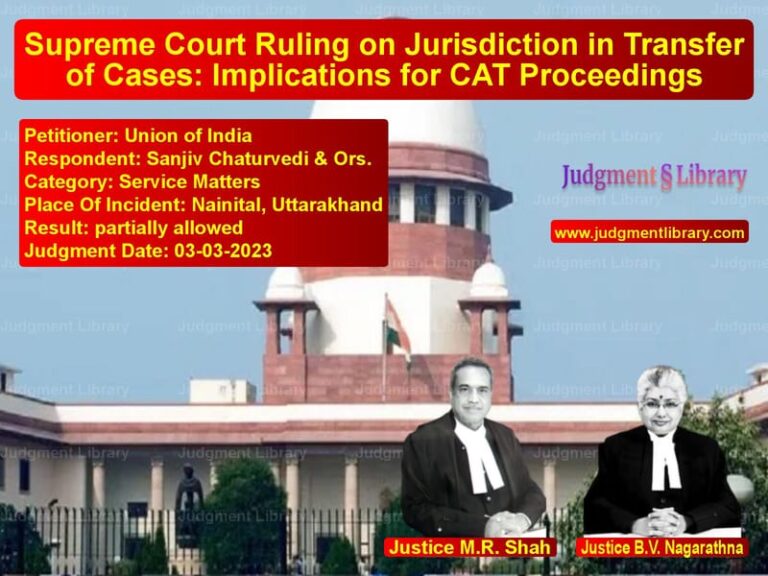Oachira Parabrahma Temple vs. G. Vijayanathakurup: Supreme Court Ruling on Temple Administration Dispute
The case of Oachira Parabrahma Temple & Anr. vs. G. Vijayanathakurup & Ors. is a landmark judgment concerning the governance of temple administration and the rights of elected bodies managing religious institutions. This Supreme Court ruling arises from a long-standing dispute over the management of the Oachira Parabrahma Temple in Kerala. The case primarily addresses the removal of the temple’s elected Executive Committee and the imposition of an Administrative Head by the Kerala High Court.
Background of the Case
The appellants, who were elected as Secretary and President of the Oachira Parabrahma Temple, challenged two orders passed by the Kerala High Court that altered the governance structure of the temple. The temple, which lacks a consecrated idol or a sanctum sanctorum, operates under a unique administrative framework governed by its Bye-laws.
In 2006, a group of devotees filed a suit (OS No. 1/2006) before the Additional District Court, Kollam, seeking to frame a legal scheme for the administration of the temple. The trial court passed a preliminary decree on April 9, 2010, directing that a scheme be formulated. Until such a scheme was framed, the temple continued to be governed by its Bye-laws.
High Court’s Intervention
During the appeal process, the Kerala High Court appointed an Advocate Commissioner to oversee the temple’s financial affairs. In a subsequent ruling, the High Court directed that the trial court finalize the scheme within a year. However, the High Court took an additional step by appointing a retired judge as the Administrative Head of the temple, giving him full supervisory control over the elected bodies.
Arguments by the Petitioners
The petitioners contended that:
- The High Court exceeded its jurisdiction by appointing an Administrative Head over the elected bodies.
- The existing system of governance, which included an Executive Committee, was functioning properly.
- The appointment of an unelected individual to oversee the administration was contrary to the temple’s customs and practices.
- The High Court, having disposed of the appeal, had become functus officio and thus lacked the authority to entertain subsequent applications modifying the governance structure.
Arguments by the Respondents
The respondents, including certain devotees and the State authorities, argued that:
- The temple’s administration was in disarray, necessitating court intervention.
- The elected bodies were not functioning transparently and were mismanaging temple funds.
- Given the lack of a proper governing framework, appointing an Administrative Head was a necessary step to ensure smooth operations.
Supreme Court’s Analysis
The Supreme Court examined the key legal issues:
- Whether the High Court had the authority to appoint an Administrative Head over an elected body.
- Whether the actions of the High Court were consistent with the principles of natural justice and the temple’s governing framework.
- Whether the temple’s Executive Committee should have been removed without holding an election.
The Court observed:
“The appointment of an Administrative Head should not come at the cost of the temple’s traditional governance. The elected bodies should have been given a fair opportunity to conduct affairs before such an imposition.”
Final Judgment
The Supreme Court ruled in favor of the appellants and passed the following directives:
- The appointment of the Administrative Head by the High Court was set aside.
- A new election was ordered to be conducted within four months.
- The temple’s finances and management were to be overseen by an interim Administrator until the elections were held.
- The trial court was directed to finalize the scheme for the temple’s administration expeditiously.
Conclusion
This ruling underscores the importance of respecting the governance structures of religious institutions while ensuring transparency and accountability. The Supreme Court’s decision ensures that the temple’s management remains in the hands of duly elected representatives rather than being controlled by an external administrator imposed by judicial intervention.
Petitioner Name: Oachira Parabrahma Temple & Anr..Respondent Name: G. Vijayanathakurup & Ors..Judgment By: Justice Sanjiv Khanna, Justice Sanjay Kumar, Justice R. Mahadevan.Place Of Incident: Kerala.Judgment Date: 02-12-2024.
Don’t miss out on the full details! Download the complete judgment in PDF format below and gain valuable insights instantly!
Download Judgment: oachira-parabrahma-t-vs-g.-vijayanathakurup-supreme-court-of-india-judgment-dated-02-12-2024.pdf
Directly Download Judgment: Directly download this Judgment
See all petitions in Property Disputes
See all petitions in Succession and Wills
See all petitions in Contract Disputes
See all petitions in Judgment by Sanjiv Khanna
See all petitions in Judgment by Sanjay Kumar
See all petitions in Judgment by R. Mahadevan
See all petitions in allowed
See all petitions in supreme court of India judgments December 2024
See all petitions in 2024 judgments
See all posts in Civil Cases Category
See all allowed petitions in Civil Cases Category
See all Dismissed petitions in Civil Cases Category
See all partially allowed petitions in Civil Cases Category

